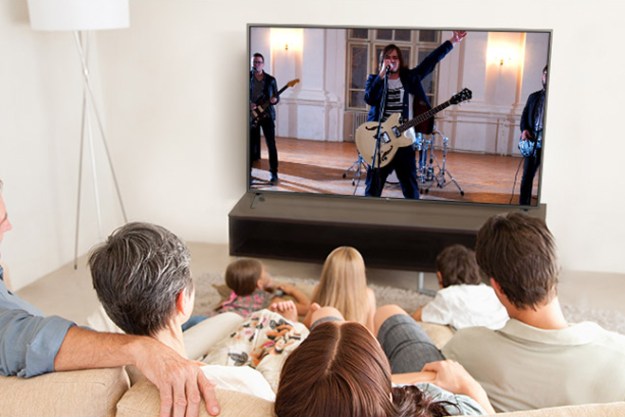Another CES has come and gone, and while we’re suitably exhausted, battling the challenges of the show floor paid back in spades this year. This time last year, we actually struggled to come up with enough ideas for a compelling top-five list – we just weren’t that blown away. But this year, we have the opposite problem, thanks to a glut of jaw-dropping new tech. Check out our list of the best audio and video products we saw at this year’s show. We hope you enjoy checking them out as much as we did.
Check out more top picks in our best of CES 2013 rundown.
Sony 4K OLED TVPicking this year’s best TV was a no-brainer. While the arrival of Sony’s 4K OLED TV came as a surprise, that it put out the most amazing picture we’ve ever seen was not. The images we saw were so vibrant, realistic and just flat-out delicious, we wanted to eat them. We’ve always believed that the day 4K resolution (Ultra HD if you ask anyone else) got married to OLED display technology would mark the arrival of the holy grail in television; we just didn’t expect to see it so soon. Well played, Sony. For more check out Sony’s banks on NFC and 4K, teases 4K OLED TV.  |
DTS Headphone XOne of the best things we heard at CES this year is something we can’t show you. That’s because DTS’ Headphone X virtual surround processing is a type of technology, not a physical product. DTS changed our minds about virtual surround sound, successfully converting us from vocal dissenters to flamboyant evangelists. The experience we had at DTS’ demo booth was incredibly convincing; we just hope the technology makes its way from mobile devices to home audio and video components really quickly. For more check out DTS bulldozes through the usual virtual surround gimmickry with Headphone X.  |
Klipsch StadiumAt $2,000, the Klipsch Stadium wireless speaker system is just too damn expensive for our liking. But that doesn’t change the fact that it sounds amazing and looks extremely cool. Though Monster’s Katana is a very close second in sound quality (and, at $700, much more reasonably priced) the Stadium earns our pick thanks to sound that is so powerful and evocative, we had a hard time peeling ourselves away from Klipsch’s booth. For more check out Klipsch’s Stadium sounds as big as it costs.  |
GoldenEar Technology Triton Seven loudspeakerAt CES, sometimes you have to forage to find the really good stuff. That was the case with the Triton Seven loudspeaker, but it was worth braving the long lines and crowded elevators at the Venetian hotel to find GoldenEar Technology. The company’s aim is to deliver truly high-end audio at prices the average Joe can live with, and it has totally nailed it with the Triton Seven speaker, which served up sound on par with speakers costing – no exaggeration here – 10 times as much. If value were a crown, we’d have to put it atop GoldenEar Technology’s head. For more check out Forget $60,000 speakers, we’ll take the GoldenEar Technology Triton Seven.  |
Sennheiser ie800 audiophile earbudsIf you want to argue that nobody has any business selling a $1,000 pair of earbuds, then we won’t stand in your way. But if any company has a chance in hell of justifying such a move, then it would be Sennheiser with its ie800 in-ear headphones. That an earbud could possibly sound this good is a marvel of engineering, and Sennheiser deserves copious props for making it happen. The ‘buds rocked our ears with sound so sweet, we’d be willing to swear off full-sized headphones for good if we weren’t so worried about losing them. For more check out $1,000 earbuds top Sennheiser’s impressive new line-up of headphones.  |
Editors' Recommendations
- What we want to see from the next Apple TV 4K
- Sony debuts the Bravia 9, its brightest 4K TV ever, alongside new 2024 models
- You Asked: QLED and mini-LED burn-in, missing HDR, and Apple TV and HDMI 2.1
- Vizio’s first 86-inch 4K TV is coming soon, for $999
- Samsung QN90D first look: setting the bar for 2024




